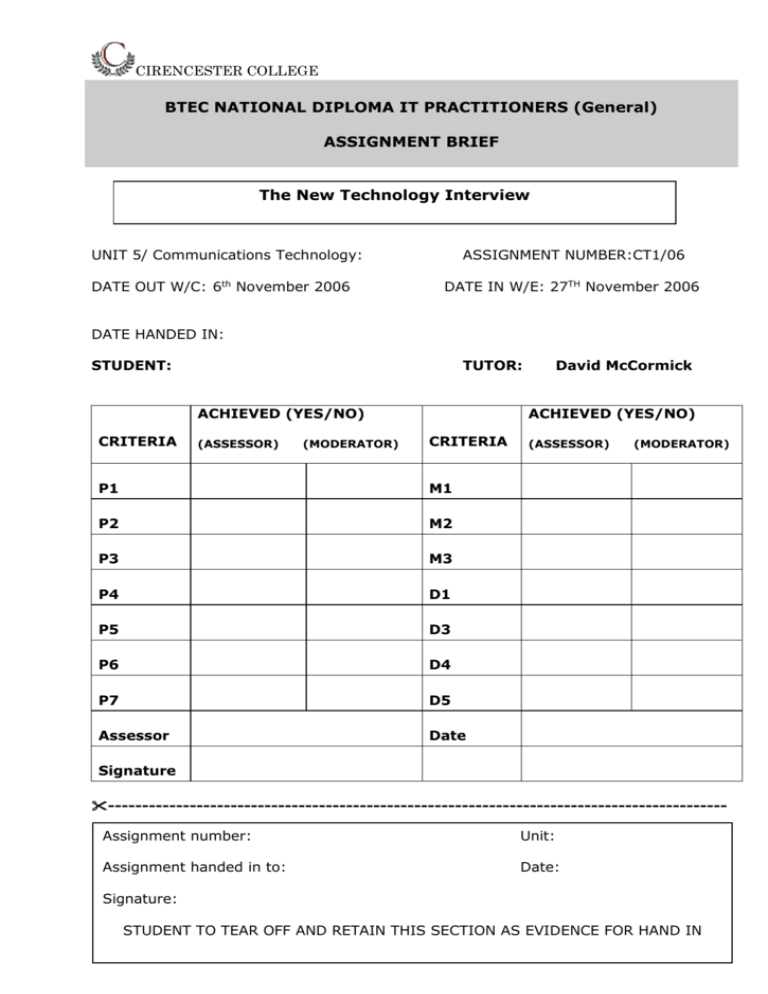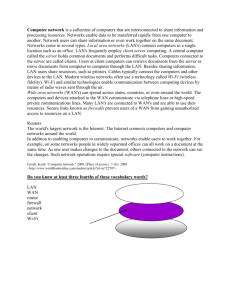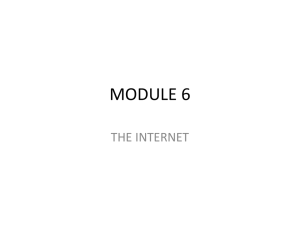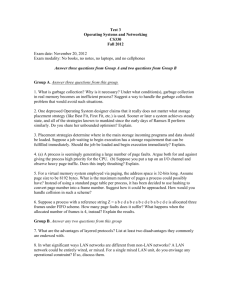Assignment 1
advertisement

CIRENCESTER COLLEGE BTEC NATIONAL DIPLOMA IT PRACTITIONERS (General) ASSIGNMENT BRIEF The New Technology Interview UNIT 5/ Communications Technology: DATE OUT W/C: 6th November 2006 ASSIGNMENT NUMBER:CT1/06 DATE IN W/E: 27TH November 2006 DATE HANDED IN: STUDENT: TUTOR: ACHIEVED (YES/NO) CRITERIA (ASSESSOR) (MODERATOR) David McCormick ACHIEVED (YES/NO) CRITERIA P1 M1 P2 M2 P3 M3 P4 D1 P5 D3 P6 D4 P7 D5 Assessor Date (ASSESSOR) (MODERATOR) Signature ------------------------------------------------------------------------------------------Assignment number: Unit: Assignment handed in to: Date: Signature: STUDENT TO TEAR OFF AND RETAIN THIS SECTION AS EVIDENCE FOR HAND IN CIRENCESTER COLLEGE ASSESSOR COMMENTS SIGNED: DATE: MODERATOR COMMENTS SIGNATURE: DATE: SIGNED: DATE: Key Skill Level C3.2 Element(s) Read and synthesise information from two extended documents about a complex subject. One of these documents should include at least one image. Achieved? CIRENCESTER COLLEGE ASSIGNMENT BRIEF Scenario New Technology are a network service provide. Who implement and control a number of Local Area Networks and Wide Area Networks. You have been short listed for the job of Trainee Network Support Technician with them. In order for them to better evaluate you they wish you to provide some written answers to a number of questions that will explore your knowledge of LAN’s and WAN’s The Questions Analogue and Digital signals are used to transmit data on both Local Area Networks and Wider Area networks. Describe both signalling methods and distinguish between the two. (P1) Describe the role of a modem in computer communications. (P1) Various protocols are used in data communications Describe the main functions of a communications protocol. (P2) Identify the alternative forms of communication media and provide examples of their use in different forms of network. (P3) Please note that extra credit will be given if the answer includes reference to how understand basic signal theory can affect the choice of transmission methods and media. (M1) Describe and illustrate the role of the various components which make up a LAN (P4) Draw the main LAN topologies and explain the difference between them in the ways that data flows around a network. (P5) and explain the explain the functioning of the main LAN access control methods. (D4) Identify and describe the basic roles of a range of interconnection devices. (P6). Please note that extra credit can be obtain if you can show an understand of the selection criteria for these devices usage within a LAN. (M3) Further Credit will be given if you can further explain the OSI seven layer model in relation to these interconnection devices. (D3) Outline the differences between the various communication channels available such as Duplex and Half Duplex (M2). Extra credit will be given if you can provide a short evaluation of how various communication channels relate too the different wireline media available. (D1) Outline the difference between the internet and the worldwide web describe a range of services they provide. (P7) Identify and describe the functions of the main hardware and software elements which make up the internet and worldwide web. (D5) PLEASE NOTE THAT WORK WILL NOT BE MARKED AFTER THE FINAL DEADLINE FOR THE UNIT CIRENCESTER COLLEGE Grading Criteria To achieve a pass grade the evidence must show that the learner is able to: P1- distinguish between analogue and digital signalling and describe the role of a modem in computer communications Evidence To achieve a merit grade the evidence must show that the learner is able to: M1- understand basic signal theory and how it affects the choice of transmission methods and media P2- describe the main functions of a communications protocol M2 understand the differences between the various communication channels available P3- identify the alternative forms of communication media and provide examples of their use in different forms of network M3 understand the selection criteria for LAN interconnection devices. P4- describe and illustrate the role of the various components which make up a LAN P5- draw the main LAN topologies and explain the difference between them in the ways that data flows around a network P6- identify and describe the basic roles of a range of interconnection devices Evidence To achieve a distinction grade the evidence must show that the learner is able to: D1 evaluate current transmission methods and media and assess suitability of each for a particular communications channel D3 explain the OSI seven layer model in relation to interconnection devices D4 explain the functioning of the main LAN access control methods D5 identify and describe the functions of the main hardware and software elements which make up the internet and worldwide web. Evidence CIRENCESTER COLLEGE P7- distinguish between the internet and the worldwide web and describe a range of services they provide. Guidelines. Pass: To achieve a pass learners will demonstrate knowledge of the terminology and be able to explain at a basic level the meaning of various terms and acronyms. Stating the basic concepts may be via written evidence or by oral questioning reported and signed by the tutor. It is important that learners have a grasp of the basic electrical characteristics of a communication system. Merit: To achieve a merit learners must understand how a complex communication system is built up, and can relate the layers of the OSI model to physical hardware and software protocols. Distinction: To achieve a distinction learners will have studied in depth various types of communication technology and will be able to produce a comparative analysis in written form with appropriate and clearly argued conclusions.


![Network Technologies [Opens in New Window]](http://s3.studylib.net/store/data/008490270_1-05a3da0fef2a198f06a57f4aa6e2cfe7-300x300.png)






